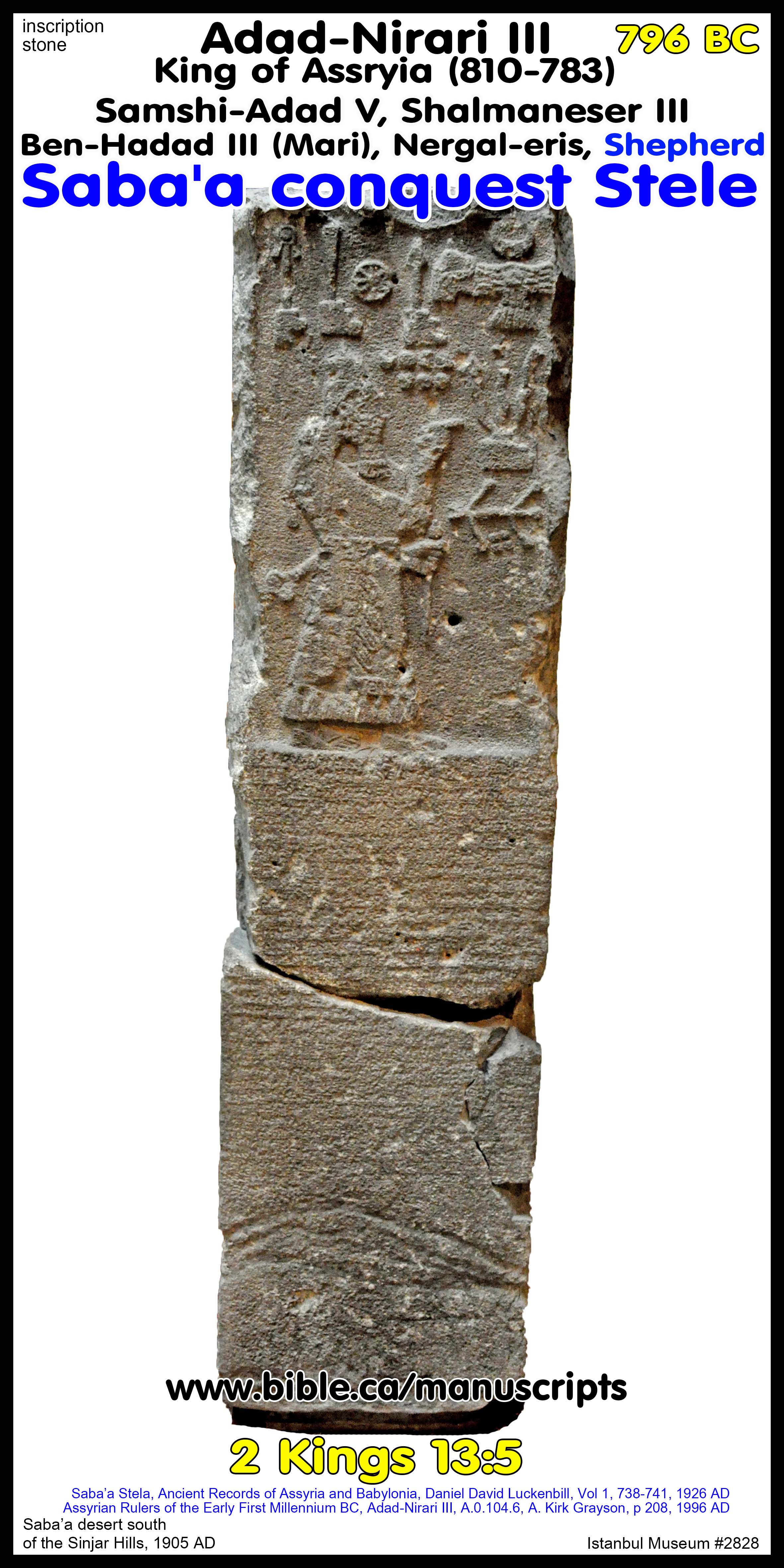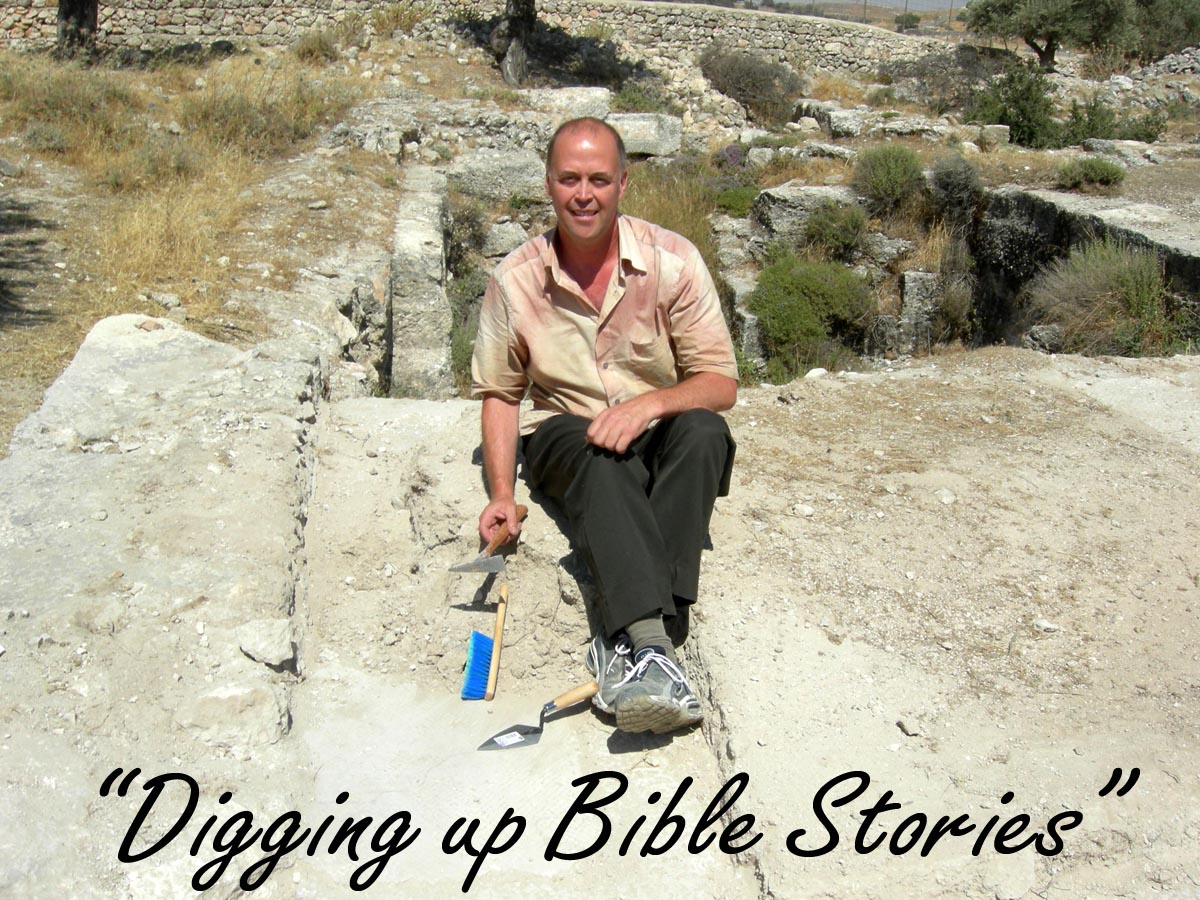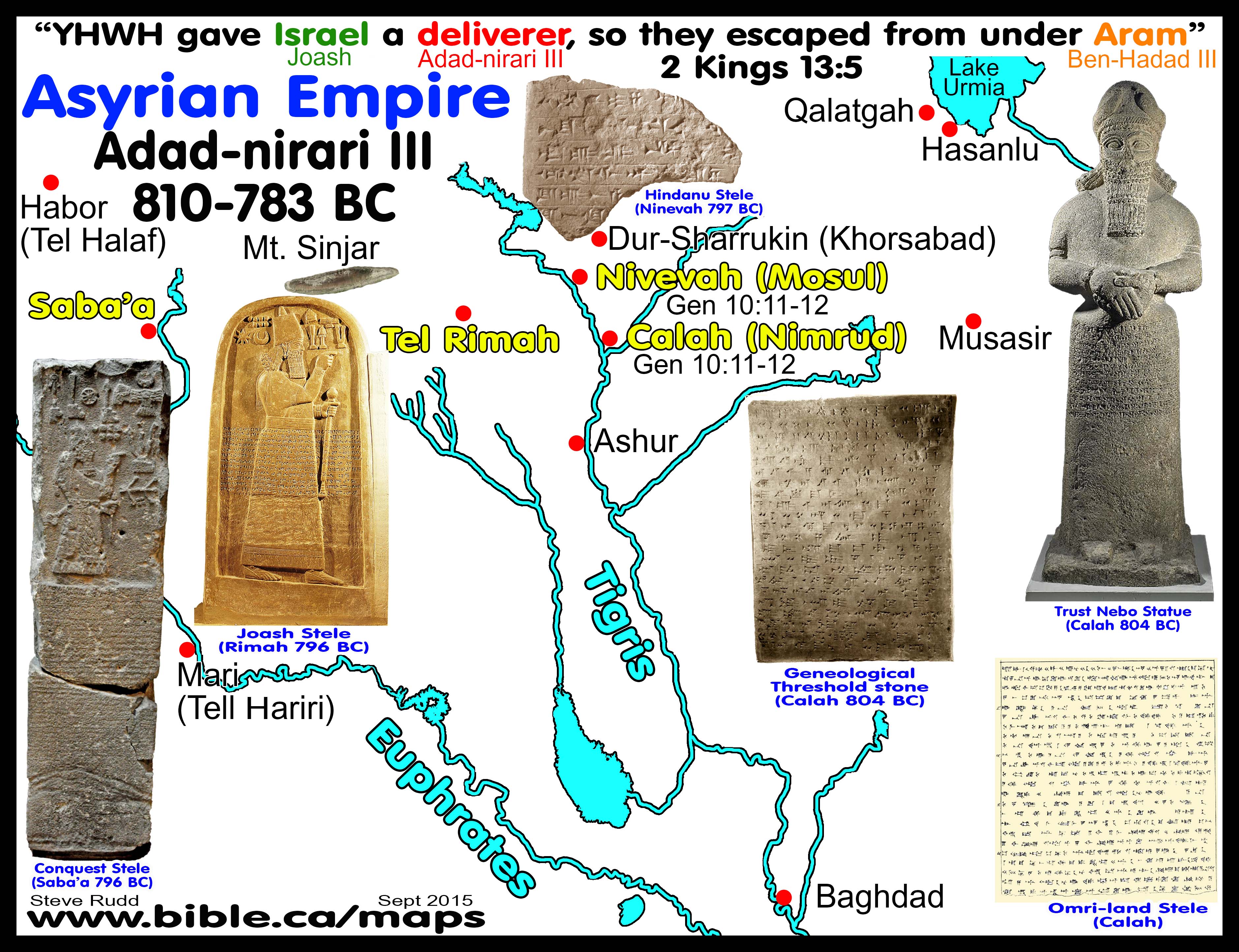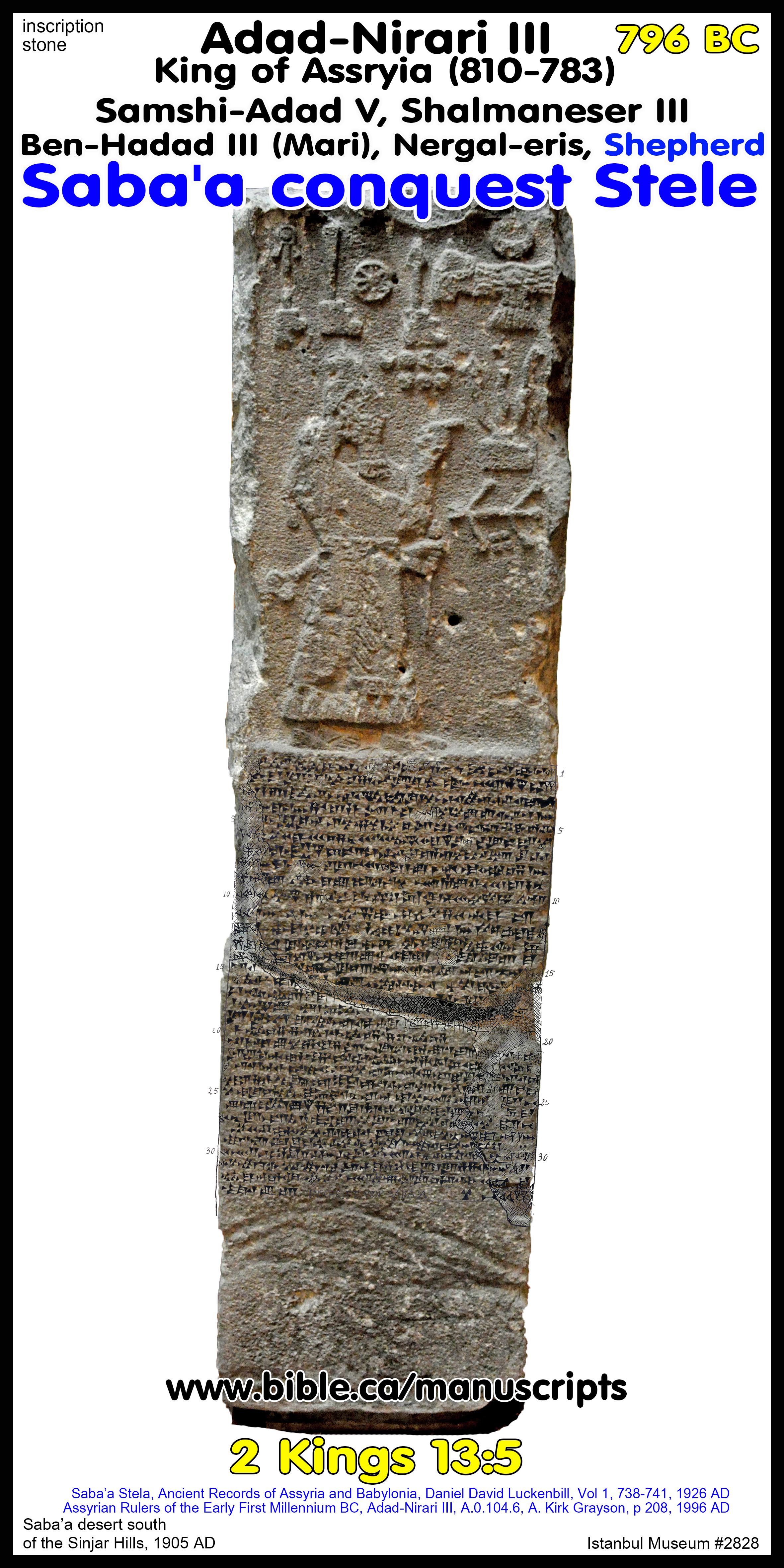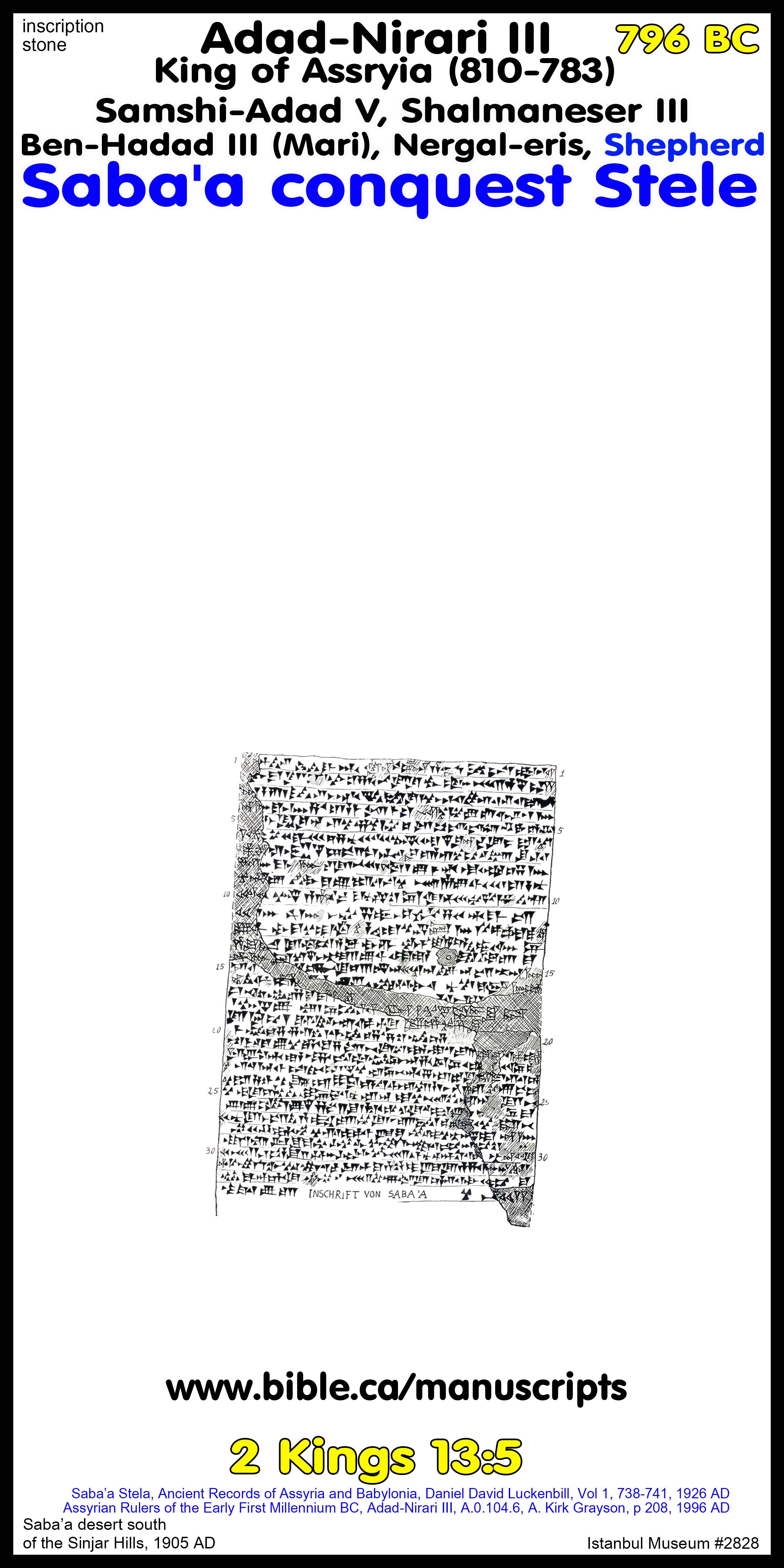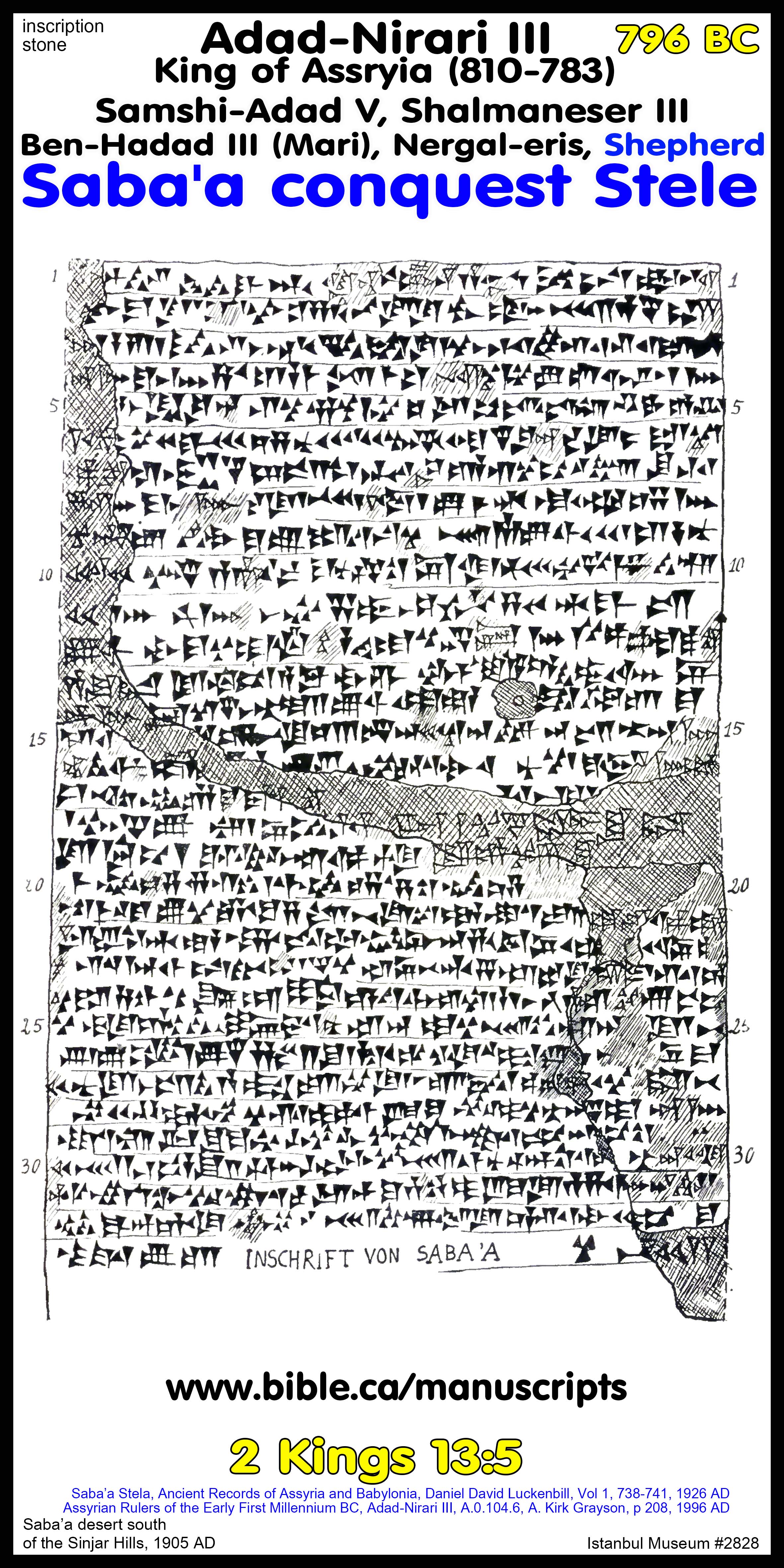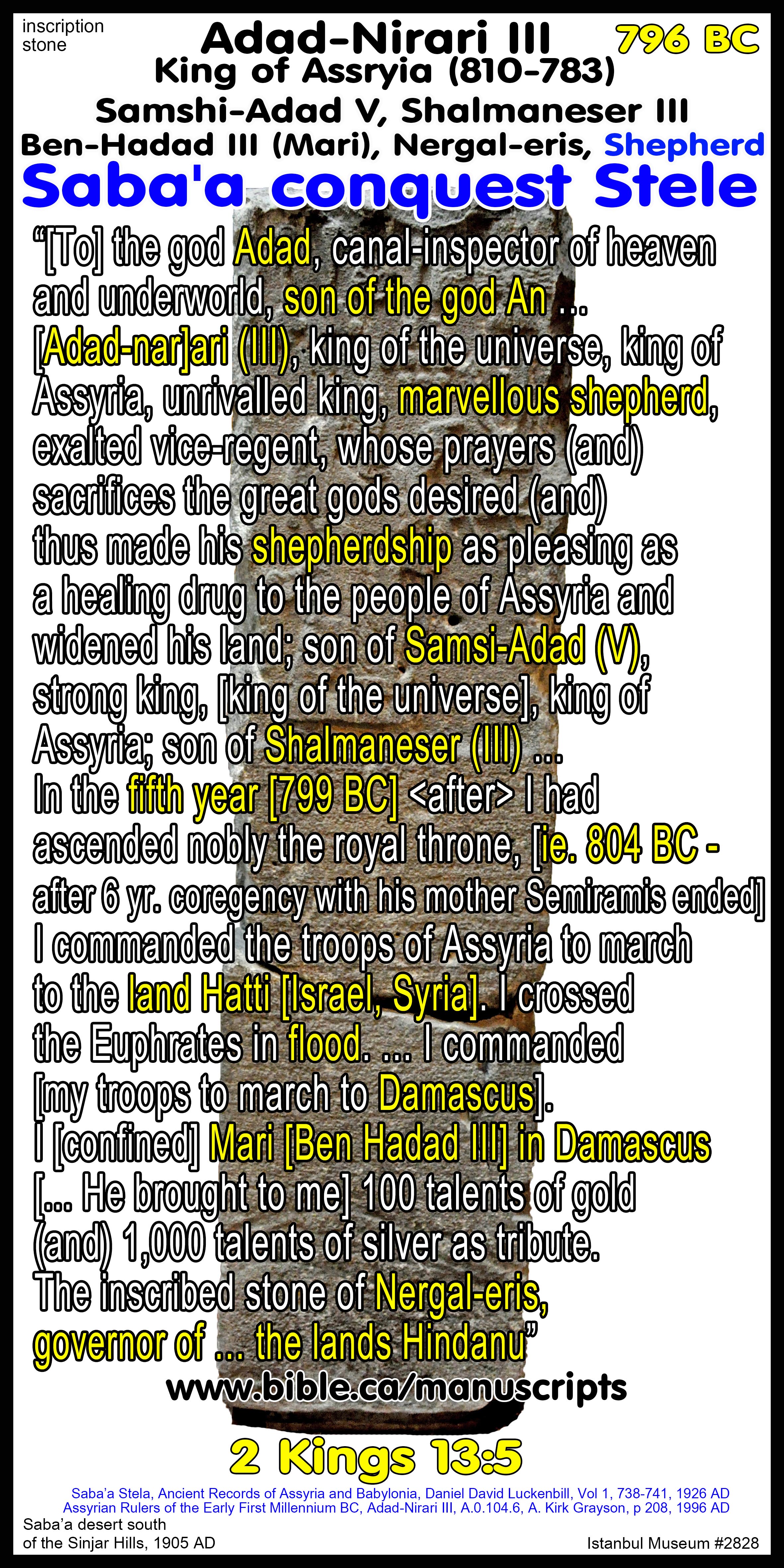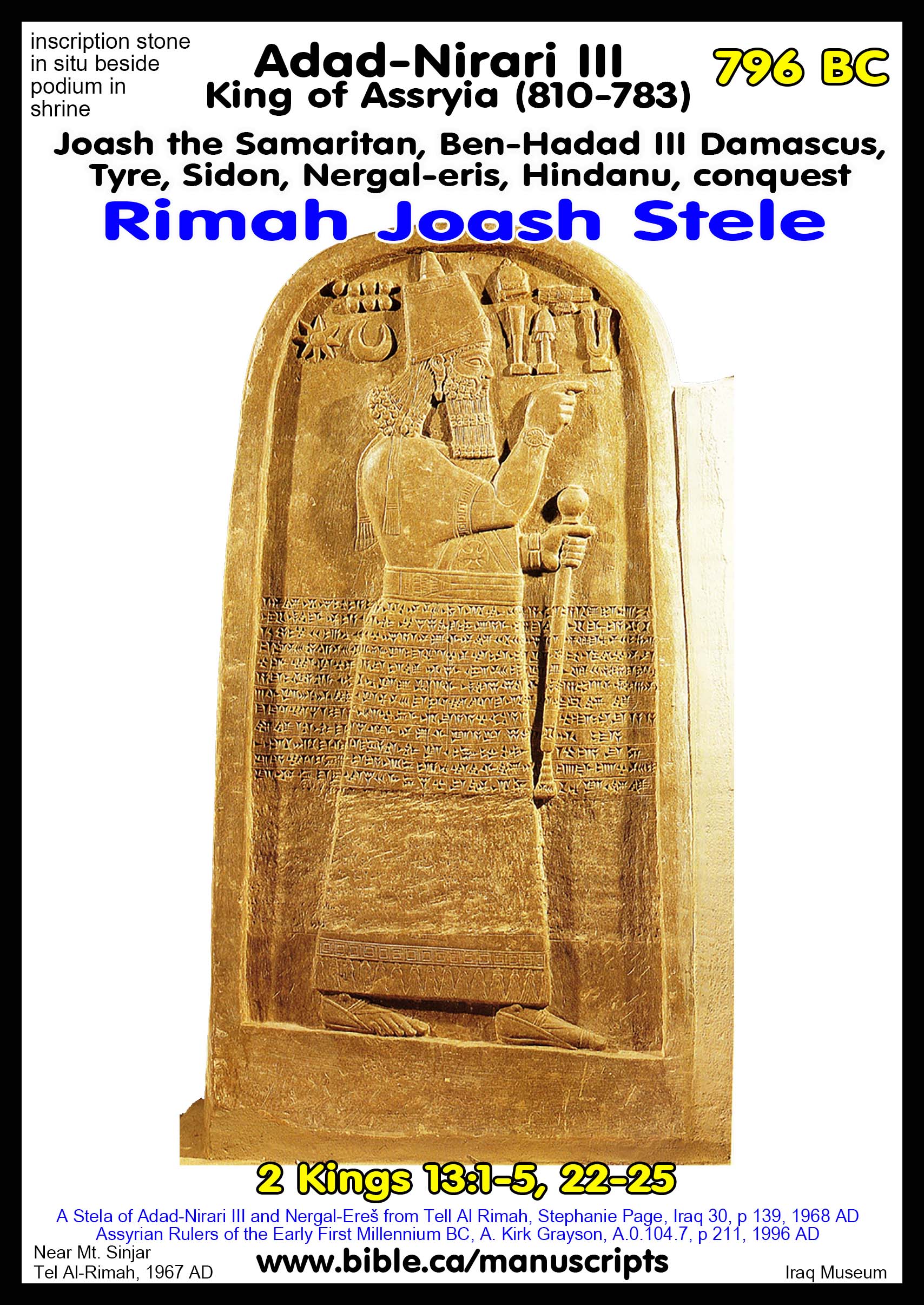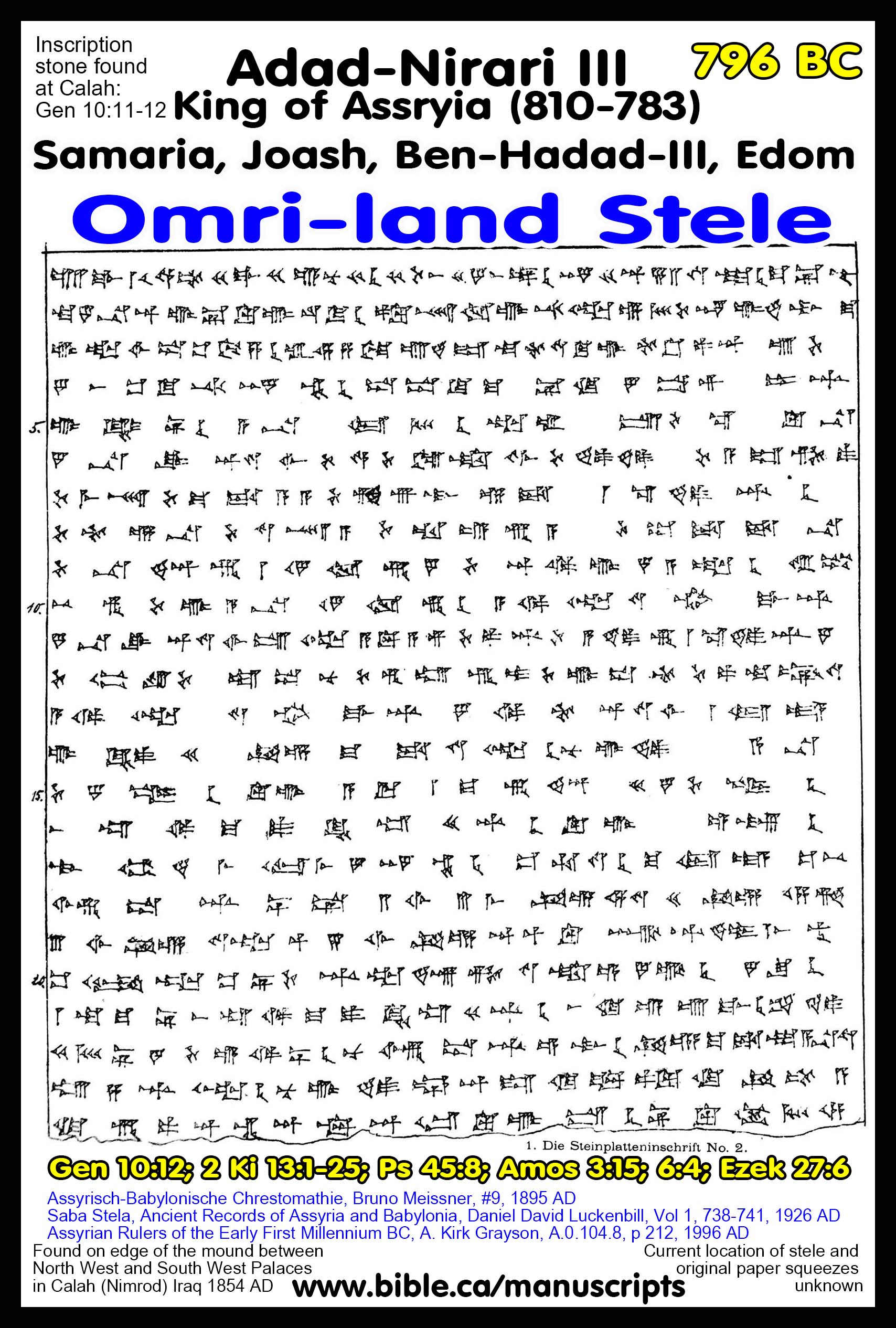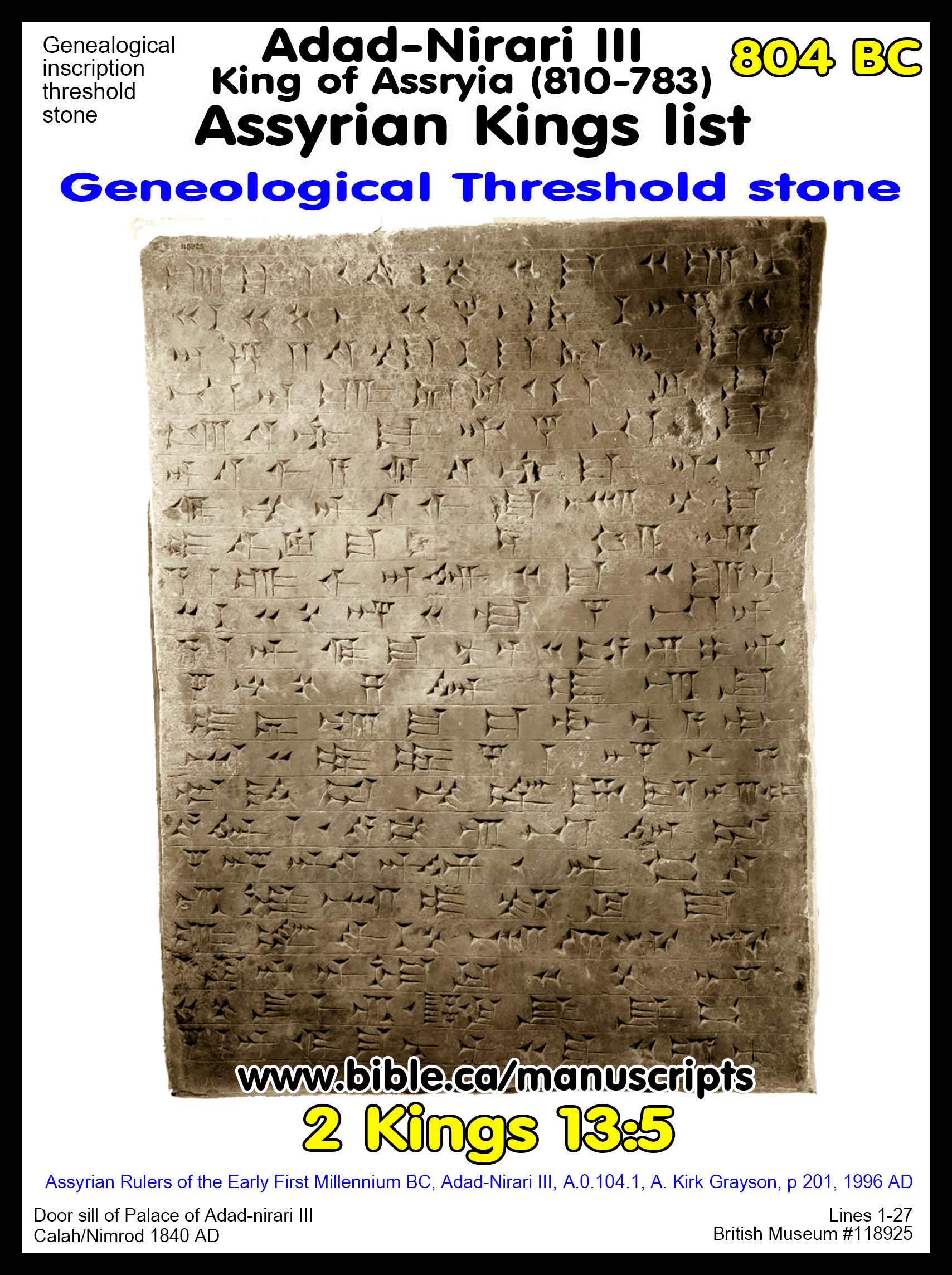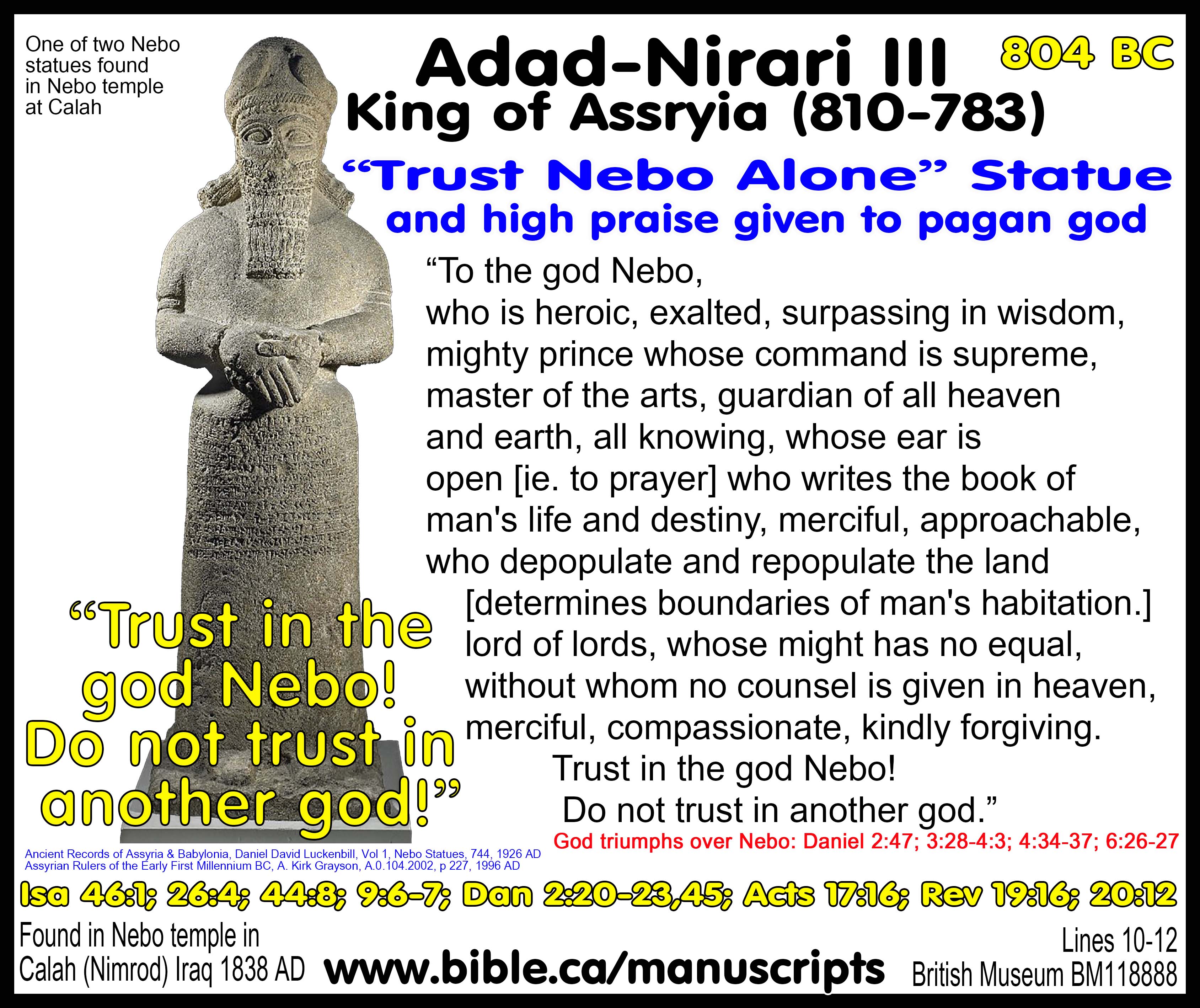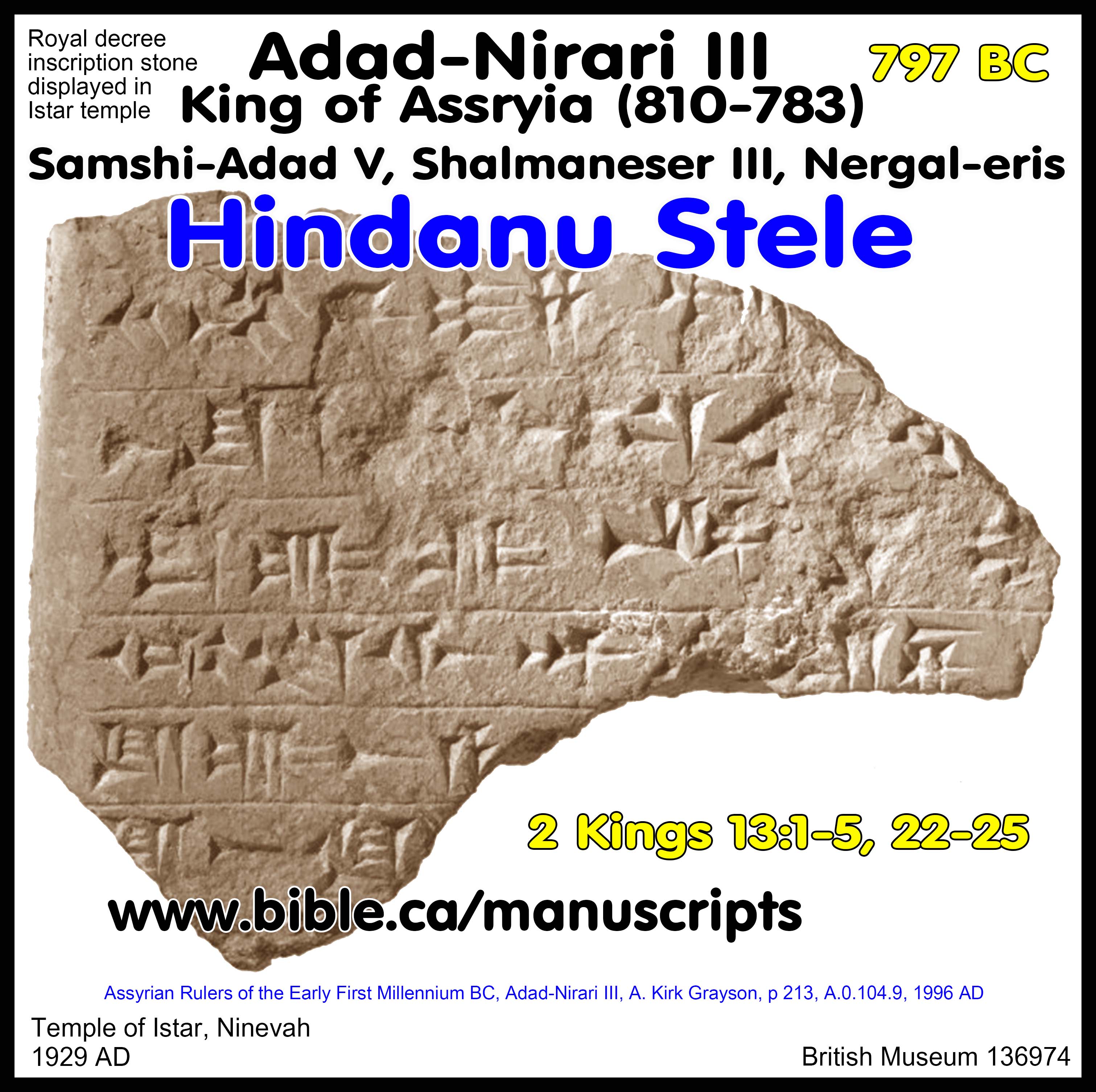Adad-Nirari III, King of Assyria (810-783)
"Saba'a Conquest Stele" 796 BC: 2 Kings 13:5
|
Adad-Nirari III (810 - 783 BC) "The unknown deliverer" |
||
|
2 Kings 13:5 |
||
|
"YHWH gave Israel King Jehoahaz & Joash (Israel) |
a deliverer King Adad-nirari III (Assyria) |
they escaped Aram" King Ben Hadad III (Aram) |
Describes in stone the conquest of Adad-nirari III in 796 BC in the bible: 2 Kings 13:5
|
Saba'a Conquest Stele of Adad-nirari III: 796 BC
"[To] the god Adad, canal-inspector of heaven and underworld, son of the god An … [Adad-nar]ari (III), king of the universe, king of Assyria, unrivalled king, marvelous shepherd, exalted vice-regent, whose prayers (and) sacrifices the great gods desired (and) thus made his shepherdship as pleasing as a healing drug to the people of Assyria and widened his land; son of Samsi-Adad (V), strong king, [king of the universe], king of Assyria; son of Shalmaneser (III) … In the fifth year [799 BC] <after> I had ascended nobly the royal throne, [ie. 804 BC – after 6 year coregency starting in 810 BC with mother ended] I commanded the troops of Assyria to march to the land Hatti [Israel, Syria]. I crossed the Euphrates in flood. … I commanded [my troops to march to Damascus]. I [confined] Mari [Ben Hadad III] in Damascus [... He brought to me] 100 talents of gold (and) 1,000 talents of silver as tribute. The inscribed stone of Nergal-eris, governor of … the lands Hindanu” (Saba'a Stele, Adad-nirari III, 796 BC) |
|
Digging up Bible stories! The Hindanu Stele allows us to firmly date the Saba'a conquest Stele to 796 BC and confirm the story of where God delivered Israel out of the hand of Ben Hadad III (son of Hazael), king of Aram in 2 Kings 13:5
God sent Israel (Jehoahaz and Joash, Samaria) a deliverer (Adad-nirari III, Assyria) they escaped Aram (Ben Hadad III, Aram)
Detailed outline on Adad-Nirari III "What we read in the book, we find in the ground" |
Introduction:
- The Saba'a stone Stele was discovered in 1905 AD at Saba'a, south of the Jebel Sinjar
- A portrait of Adad-nirari III is at the top with the divine symbols of his pagan gods while the text is inscribed in cuneiform below.
- It describes the story in 2 Kings 13:5 where God sent Adad-nirari III to be the "deliverer of Israel" out of the hand of Ben-Hadad III (son of Hazael), king of Aram.
- The "Hindanu Land" connection:
- On the Saba'a Stele it notes at the end that governor Nergal-eris, was in control of the land of "Hindanu".
- Another artifact, the "Hindanu Stele" was a royal proclamation in 797 BC written under the authority of the Assyrian king Adad-nirari III that grants Nergal-eris, governor of the land Rasappa, a new parcel of lands under his governorship.
- The date on the Hindanu Stele "Month of Sivan, twenty-fourth day, [eponymy of] Bel-tarsi-ilumma" translates to 797 BC.
- The reason this stele is important is that it helps us date another, far more important archeological Saba'a Stele which records the exact events of 2 Kings 13:5.
- The Hindanu Stele helps us confirm the story of where God delivered Israel out of the hand of Ben-Hadad III (son of Hazael), king of Syria in 2 Kings 13:5
- So since we know that Nergal-eris got the land of Hindanu in 797 BC, this dates the Saba'a stele to the conquest of Adad-nirari III in 796 BC, exactly the same date as the story in 2 Kings 13:5!!!
- Infant Adad-nirari III coregent with his mother Semiramis:
- Young Adad-nirari III becomes king of Assyria but his mother “Semiramis” is coregent with him for 6 years.
- We do not know how old he was when he became king, but the dynastic father son transmission of kings was as strong in Assyria as it was in Judah.
- Here we have two kings (Joash of Judah and Adad-nirari III) who ascended the throne as infants while their mothers (Athaliah, Semiramis) ruled the kingdom for them for 6 years.
- What is even more amazing is that they were king at the same period of time with an overlapping governorship of 14 years.
- This may have created an affinity between the Hebrews and Assyria as the two child kings governed their parts of the world at the same time.
- Joash king of Judah and Adad-nirari III were:
a. Both Infants when their fathers died
b. Both had coregent mothers (Athaliah, Semiramis)
c. Both had coregencies of 6 years
5. Summary of Adad-Nirari III’s reign:
a. Six-year coregency with mother “Semiramis”: 810-806 BC
b. First functioning year as sole monarch: 806 BC
c. 5th year of reign as sole monarch on Stele: 799 BC
d. 4 year Fulfilment of 2 Ki 13:5: 799 BC (Jehoahaz/Israel) - 796 BC (Joash/Israel)
e. Dies and his son Shalmaneser IV becomes king of Assyria
- The Bible connection with the Saba'a Stele: 2 Kings 13:5
- From archeology we can date this bible event to 796 BC, one year after Hindanu Stele was set up granting the land of Hindanu to governor Nergal-eris.
- "The Lord gave Israel a deliverer, so that they escaped from under the hand of the Arameans; and the sons of Israel lived in their tents as formerly." (2 Kings 13:5)
- That deliverer was none other than Adad-nirari III, king of Assyria!
- About the two Israeli kings:
- Jehoahaz king of Israel 814-798 BC was made the promise of the deliverer in 2 Ki 13:5
- Joash (Jehoash) was king of Israel 798-782 BC who had continued back and forth warfare with Ben-hadad III, king of Aram (son of Hazael).
- Interesting details found in the Saba'a stele:
- DATING: It tells of the conquest campaign of Adad-nirari III dating to 796 BC which equals 2 Kings 13:5 "The inscribed stone of Nergal-eris, governor of … the lands Hindanu” (Saba'a Stele, Adad-nirari III, 796 BC)
- A SHEPHERD: Adad-nirari III is called a "Shepherd" and describes his job as king as "shepherdship": "[Adad-nar]ari (III), king of the universe, king of Assyria, unrivalled king, marvelous shepherd, exalted vice-regent, whose prayers (and) sacrifices the great gods desired (and) thus made his shepherdship as pleasing as a healing drug to the people of Assyria and widened his land” (Saba'a Stele, Adad-nirari III, 796 BC)
- RIGHTEOUS: The gods eagerly desire the prayers and sacrifices Adad-nirari III makes to them: "[Adad-nar]ari (III) … whose prayers (and) sacrifices the great gods desired” (Saba'a Stele, Adad-nirari III, 796 BC)
- THE GREAT PHYSICIAN: "LIKE A HEALING DRUG": Adad-nirari III described himself as a cure for his nations problems. [Adad-nar]ari (III) … thus made his shepherdship as pleasing as a healing drug to the people of Assyria and widened his land” (Saba'a Stele, Adad-nirari III, 796 BC)
- Ben-hadad III king of Aram (son of Hazael) is named "Mari" in three stele of Adad-nirari III:
- What you read in the book you find in the ground!
I. The pagan idol god Hadad (Adad)
- It is amazing that both Adad-nirari III (king of Assyria) and Ben-Hadad III (king of Aram at Damascus) were named after the SAME PAGAN GOD: HADAD
- Adad and Hadad are two different spellings of the same "storm god"
- Adad-nirari III is literally “Adad is my helper"
- Ben-Hadad is literally "son of Hadad"
- We find the same thing true with all the Babylonian kings being named after idol gods Bel or Nebo. (Nebuchadnezzar)
- "Adad (Addu, Akkadian), Hadda/i/u (West Semetic), storm-god. may also stand for Baal" (The Amarna Letters, W. L. Moran, p 386, 1992 AD)
- "Hadad is the name under which the ancient Near Eastern storm god was known among various groups in the Mesopotamian and Syrian world. The god is also mentioned in a number of biblical texts and names. In this article, the biblical material will be dealt with in conjunction with the epigraphic data from the Near East. Hadad makes his first appearance as Adad in Old Akkadian texts, and in this guise he is important in the Mesopotamian world through the neo-Assyrian and neo-Babylonian periods. Hadad in all likelihood means ‘thunderer’ and as the storm-god he brings both fertility through abundant rains and destruction through fierce winds and storms. His voice (rigmu) can be a sign of both blessing and curse." (Dictionary of Deities and Demons in the Bible, Hadad, 1999 AD)
II. The Bible story of God saving Israel from Syrian through Adad-Nirair in 797 BC
- Adad-nirari III is specifically but indirectly referenced in 2 Kings 13:5 as the "deliverer" sent by God to save Israel from Damascus.
- The entire story is told here: 2 Kings 13:1-5; 24-25
- "In the twenty-third year of Joash the son of Ahaziah, king of Judah, Jehoahaz the son of Jehu became king over Israel at Samaria, and he reigned seventeen years. He did evil in the sight of the Lord, and followed the sins of Jeroboam the son of Nebat, with which he made Israel sin; he did not turn from them. So the anger of the Lord was kindled against Israel, and He gave them continually into the hand of Hazael king of Aram, and into the hand of Ben-hadad the son of Hazael. Then Jehoahaz entreated the favor of the Lord, and the Lord listened to him; for He saw the oppression of Israel, how the king of Aram oppressed them. The Lord gave Israel a deliverer, so that they escaped from under the hand of the Arameans; and the sons of Israel lived in their tents as formerly." (2 Kings 13:1–5)
- "When Hazael king of Aram died, Ben-hadad his son became king in his place. Then Jehoash the son of Jehoahaz took again from the hand of Ben-hadad the son of Hazael the cities which he had taken in war from the hand of Jehoahaz his father. Three times Joash defeated him and recovered the cities of Israel." (2 Kings 13:24–25)
- The Saba'a Stele (with the help of the Hindanu Stele) confirms the Bible as true history!
II. About the Saba'a Conquest Stele: 796 BC
- This is catalogued by Grayson #6: Saba'a Stella slab of Adad-nirari III, A.0.104.6
- "Our primary source for the history of the reign of Adad-nirari III (805-782 B.C.) is the inscription on a stele erected by one of his officers, Nergalerish, and discovered, 1905, in the desert south of the Sinjar Hills. The stele is now in the Constantinople Museum. … Of particular interest to the historian was the reference to the king's accession to the throne in his fifth year. This means, of course, that his mother, the famous Semiramis, was actually ruler of Assyria for five years." (Saba'a Stela, Ancient Records of Assyria and Babylonia, Daniel David Luckenbill, Vol 1, section 732, p 260. 1926 AD)
- "This text is engraved on a stone stele discovered at Saba'a, south of the Jebel Sinjar. A portrait of the king in relief and divine symbols are on the top part of the stele while the text is inscribed below. The first two-thirds of the text (lines 1-22) are a royal dedicatory inscription; then Nergal-erg, a governor under Adad-nirari III, is introduced with his titles (lines 23-25). In the concluding curses Nergal-eris speaks in the first person (lines 26-33). Regarding other texts of Nergal-eris see the introduction above. The text opens with a dedication to the god Adad (lines 1-5), followed by Adad-nirari III's name, epithets, and genealogy (lines 6-11a). Then the author introduces the military narrative with a date, "In the fifth year," and describes a campaign against Hatti and the submission of Damascus. As we know from the eponym chronicle, there were several campaigns to the west, between 805 and 796 BC, and the description on this stele is just a brief summary of these events. Perhaps the scribe chose to introduce the chronological note to indicate that these conquests began after "the fifth year." It is curious, however, that he did so, but then the text as a whole is strange: note the prominent role given to a governor, the unskilled manner in which the stone was carved, and the occasional faults in syntax. A date for the text can confidently be given as 797 BC, or later, since it was in that year that Hindanu was added to Nergal-eris's domain by royal decree (see A.0.104.9)." (Assyrian Rulers of the Early First Millennium BC, Adad-Nirari III, A. Kirk Grayson, p 208, A.0.104.6, 1996 AD)
III. Translation of "Hindanu Stele" of Adad-Nirari III:
|
"[To] the god Adad, canal-inspector of heaven and underworld, son of the god An … [Adad-nar]ari, great king, king of the universe, king of Assyria, unrivalled king, marvelous shepherd, exalted vice-regent, whose prayers (and) sacrifices the great gods desired (and) thus made his shepherdship as pleasing as a healing drug to the people of Assyria and widened his land; son of Samsi-Adad (V), strong king, [king of the universe], king of Assyria; son of Shalmaneser (III) … In the fifth year <after> I had ascended nobly the royal throne, I … commanded the extensive troops of Assyria to march to the land Hatti [Israel, Syria]. I crossed the Euphrates in flood. … I commanded [my troops to march to Damascus]. I [confined] Mari in Damascus [... He brought to me] 100 talents of gold (and) 1,000 talents of silver as tribute. The inscribed stone of Nergal-eris, governor of … the lands Hindanu" (Saba'a Stele, Adad-nirari III, 796 BC) |
- "(To) Adad, foremost in heaven and on earth, son of Anu, the powerful warrior, the perfect, the mighty strength, first among the Igigi, valiant (leader) of the Anun-naki, who is clothed in splendor, who rides the mighty… s, decked with terrible brilliance, who brings low the wicked with his shining whip, who hurls the thunderbolt, the great lord, his lord; Adad-nirari, the great king, the mighty king, king of the universe, king of Assyria, the king without a rival, the wonderful shepherd, the exalted viceroy (of the gods), whose thoughts are of prayer and sacrifice (lit., raising of his hand and the giving of his offering), whose rule the gnat gods made beneficial as the food (lit., plant) of life for the people of Assyria, and whose land they enlarged; son of Shamshi-Adad, the mighty king, [king of the universe, king] of Assyria, grandson of Shalmaneser, ruler of all princes, destroyer of hostile kings. In (my) fifth year of reign, when I took my seat on the royal throne, in might, I mobilized (the forces of my) land, (to) the widespreading armies of Assyria I gave the order to advance against Palashtu (Palestine). The Euphrates I crossed at its flood. The [widespreading, hostile] kings, who in the time of Shamshi-Adad, my father, had rebelled, and withheld their tribute,—at the command of Assur, Sin, Shamash, Adad, Ishtar, the gods, my allies, [terror] over-whelmed them and they laid hold of my feet. Tribute and rtax, more than that of former days], they brought to Assyria. I received it. [To march against Aram] I gave the command. Mari' [I shut up] in Damascus, [his royal city]. 100 talents of gold, 1,000 talents of silver …. talents … I received. At that time I had an image of my royal self made. The power of my might, the deeds of my hands, I inscribed thereon. In Zabanni(?) I set it up. . . . The inscription(?) of Nergal-eresh, governor of Nimittu-Ishtar, Abku, Mare(?), Rasapu, Katni, Dur-karpati(?), opposite Kir-Assur-nasir-pal, Sirku, the lands of Lake and Hindanu, the city of Anat, the land of Suhi, and the city of … -isbat. The future prince who shall remove this image (stele) from its place, whoever shall cover it with dust or shall bring it into a house of "disease of the face(?)," who shall blot out the name of the king, my lord, or my written name, and write his own name (in their stead), may Assur, the father of the gods, curse him, may he destroy his seed, his name, in the land. May Marduk overthrow his kingdom, apportioning him (counting out for him) hands and eyes that are "bound." May Shamash, judge of heaven and earth, bring darkness into his land, together. May Adad, foremost in heaven and on earth, destroy his name, may he come on like a locust swarm and bring low his land." (Saba'a Stela, Ancient Records of Assyria and Babylonia, Daniel David Luckenbill, Vol 1, section 733, p 260. 1926 AD)
- "(Lines 1-5) [To] the god Adad, canal-inspector of heaven and underworld, son of the god Anu, the perfectly splendid hero whose strength is mighty, foremost of all the Igigu gods, warrior of the Anunnaku gods, who is bedecked with luminosity, who rides the great storms (and) is clothed with fierce brilliance, who lays low the evil, who bears a holy whip, who makes the lightning flash, the great lord, his lord: (lines 6-11a) [Adad-nar]ari, great king, strong king, king of the universe, king of Assyria, unrivalled king, marvelous shepherd, exalted vice-regent, whose prayers (and) sacrifices the great gods desired (and) thus made his shepherdship as pleasing as a healing drug to the people of Assyria and widened his land; son of Samsi-Adad (V), strong king, [king of the universe], king of Assyria; son of Shalmaneser (III), commander of all rulers, scatterer of (the inhabitants of) enemy lands: (lines 11b-20) In the fifth year <after> I had ascended nobly the royal throne, I mustered the land (and) commanded the extensive troops of Assyria to march to the land Hatti. I crossed the Euphrates in flood. The kings of the extensive [land Hatti] who, in the time of Samsi-Adad (V), my father, had become strong and withheld their [tribute] — by the command of Assur, Marduk, Adad, Mar, the gods who support me, (my) awesome radiance overwhelmed them and they submitted to me. Tribute (and) tax [...] they brought to Assyria (and) I received (it). I commanded [my troops to march to Damascus]. I [confined] Mari in Damascus [... He brought to me] 100 talents of gold (and) 1,000 talents of silver as tribute. [I received it and took it to Assyria.] (lines 21-22) At that time I had made my lordly statue and inscribed thereon my heroic victories (and) achievements. I erected it in Zabanni. (lines 23-25) The inscribed stone of Nergal-eris, governor of the cities Named-Mar, Apku, Mari, the lands Rasappa, Qatnu, the cities Dur-duklimmu, Kar Ashurnasirpal, Sirqu, the lands Laqe, Hindanu, the city Anat, the land Suhi, (and) the city (Ana)-Assur(uter)-asbat. (lines 26-33) A later prince who takes this statue from its place; whoever either covers (it) with earth or puts (it) in a Taboo House or erases the name of the king, my lord, and my name and writes his own name: may Assur, the father of the gods, curse him and destroy his seed (and) his name from the land. May the god Marduk [...] overthrow his sovereignty (and) give him up to be bound by the hands (and) over the eyes. May the god Samag, judge of heaven and underworld, cause there to be darkness in his land so that people cannot see each other. May the god Adad, canal-inspector of heaven (and) underworld, tear out (his) name (and) attack like an onslaught of locusts so that his land collapses." (Assyrian Rulers of the Early First Millennium BC, Adad-Nirari III, A.0.104.6, A. Kirk Grayson, p 208, 1996 AD)
- "In the fifth year (of my official rule) I sat down solemnly on my royal throne and called up the country (for war). I ordered the numerous army of Assyria to march against Palestine (Pa-la-áš-tu). I crossed the Euphrates at its flood. As to the numerous hostile kings who had rebelled in the time of my father Shamshi-Adad (i.e., Shamshi-Adad V) and had wi[thheld] their regular (tributes), [the terror-inspiring glam]or overwhelmed them (and) upon the command of Ashur, Sin, Shamash, Adad (and) Ishtar, my trust(-inspiring) gods, they seized my feet (in submission). I received all the tributes [ … ] which they brought to Assyria. I (then) ordered [to march] against the country Damascus (Ša-imērišu). I invested Mari’ in Damascus (Di-maš-qi) [and he surrendered]. One hundred talents of gold (corresponding to) one thousand talents of [silver], 60 talents of … [I received as his tribute]." (ANET, Saba’a Stela, lines 11–20, 282)
Conclusion:
- In 797 BC, Assyrian king Adad-nirari III gives governor Nergal-eris the land of Hindanu.
- This allows us to accurately date the more important Saba'a stele to 796 BC, the same year Adad-nirari III saved Israel (ten northern tribes) from Ben-Hadad II, king of Aram at Damacus.
- Adad-nirari III is specifically but indirectly referenced in 2 Kings 13:5 as the "deliverer" sent by God to save Israel from Damascus.
- The Rimah Joash Stele and the Hindanu Stele allows us to accurately date the Saba'a Stele to 796 BC
- The Saba'a Stele tells the exact story found in the Bible: 2 Kings 13:1-5; 24-25
- First, Jehoahaz king of Israel was delivered in 799 BC by the unknown deliverer (Adad-Nirari III) from under the bondage of Ben-Hadad III of Aram.
- Second, Joash king of Israel was delivered in 796 BC by this same unknown deliverer (Adad-Nirari III).
- The process took a few years but by 796 BC Ben-Hadad III was under the complete control of Assyria, who extracted tribute from Joash king of Israel in exchange for peace.
- The Saba'a Stele (with the help of the Hindanu Stele) confirms the Bible as true history!
- Infant Adad-nirari III coregent with his mother Semiramis:
- Young Adad-nirari III becomes king of Assyria but his mother “Semiramis” is coregent with him for 6 years.
- We do not know how old he was when he became king, but the dynastic father son transmission of kings was as strong in Assyria as it was in Judah.
- Here we have two kings (Joash of Judah and Adad-nirari III) who ascended the throne as infants while their mothers (Athaliah, Semiramis) ruled the kingdom for them for 6 years.
- What is even more amazing is that they were king at the same period of time with an overlapping governorship of 14 years.
- This may have created an affinity between the Hebrews and Assyria as the two child kings governed their parts of the world at the same time.
- Joash king of Judah and Adad-nirari III were:
a. Both Infants when their fathers died
b. Both had coregent mothers (Athaliah, Semiramis)
c. Both had coregencies of 6 years
5. Summary of Adad-Nirari III’s reign:
a. Six-year coregency with mother “Semiramis”: 810-806 BC
b. First functioning year as sole monarch: 806 BC
c. 5th year of reign as sole monarch on Stele: 799 BC
d. 4 year Fulfilment of 2 Ki 13:5: 799 BC (Jehoahaz/Israel) - 796 BC (Joash/Israel)
e. Dies and his son Shalmaneser IV becomes king of Assyria
- ADAD-NIRARI WAS A FAKE AND A COUNTERFEIT! In the Saba'a conquest stele, Adad-nirari III describes himself as: A SHEPHERD, THE RIGHTEOUS, THE GREAT PHYSICIAN.
- Jesus Christ is the true Shepherd: "“All who came before Me are thieves and robbers (Adad-nirari III), but the sheep did not hear them. “I am the door; if anyone enters through Me, he will be saved, and will go in and out and find pasture. “The thief comes only to steal and kill and destroy; I came that they may have life, and have it abundantly. “I am the good shepherd; the good shepherd lays down His life for the sheep." (John 10:8–11)
- Jesus Christ is the only righteous advocated between God and Man in whom God is pleased: "My little children, I am writing these things to you so that you may not sin. And if anyone sins, we have an Advocate with the Father, Jesus Christ the righteous;" (1 John 2:1)
- Jesus Christ if the great Physician: "But when Jesus heard this, He said, “It is not those who are healthy who need a physician, but those who are sick. “But go and learn what this means: ‘I desire compassion, and not sacrifice,’ for I did not come to call the righteous, but sinners.”" (Matthew 9:12–13)
- What you read in the book, you find in the ground! Find me a church to attend in my home town this Sunday!
|
2 Kings 13:5 |
||
|
"YHWH gave Israel King Jehoahaz & Joash (Israel) |
a deliverer King Adad-nirari III (Assyria) |
they escaped Aram" King Ben Hadad III (Aram) |
|
Conquest Stela of Adad-Nirari III (810 - 783 BC) Detailed outline on Adad-Nirari III . |
||
|
Religious and dynastic Stela of Adad-Nirari III (810 - 783 BC) |
||
By Steve Rudd: Contact the author for comments, input or corrections.
